Do-it-yourself fence from corrugated sheets: step-by-step instructions on building a fence
If you want to protect your area from prying eyes, then a fence made of corrugated sheets is an effective and inexpensive way to do this.Such fencing looks modern and attractive, and with proper installation it can last for decades without replacement or repair. Build a fence from profiled sheet Anyone can do it with their own hands, you just need to listen to the recommendations of specialists and accurately carry out the sequence of operations.
In our article we will tell you where to start building a fence, give advice on choosing and calculating materials, and give step by step instructions erection of a fence.
The content of the article:
Creating a sketch and drawing of a fence
First, a sketch is made, that is, a drawing of the future fence by hand, without exact dimensions and details. At this stage, you need to choose one of the possible fence options: continuous or sectional. Depending on the chosen model, the consumption of materials and the method of installing the structure as a whole will vary.
For an overview of the cheapest fencing options, see the article “Cheap and beautiful fence for the home - budget and original fencing methods».
On the preliminary sketch, the main characteristics of the structure are noted. Choose a place entrance gates and gates, the location of the fence relative to the buildings and landscape features of the site.
Mark the points of height difference on uneven territory to take into account the required height of the sheets. Costs are calculated based on the number of straight sections professional sheets, main and intermediate pillars and logs.When constructing a sectional fence, indicate the dimensions of the sections.
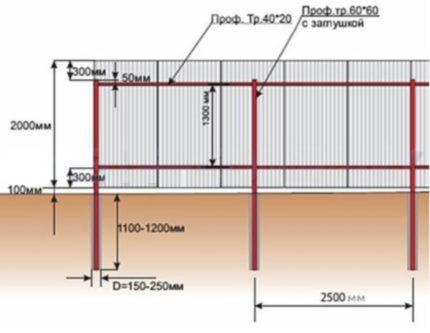
According to the accepted technology, the distance from the ground is assumed to be within 0-150 mm. If there is a slight slope of the terrain - 3-5%, then the sheets are mounted with a height difference of 150 mm. In other cases, the difference is calculated individually.
Tips for choosing a professional sheet
First of all, you should choose the best option for consumables, since the industry produces a large number of items profiled sheet. Sheets are marked with special symbols indicating possible use and load-bearing qualities (rigidity).
The optimal price-quality ratio for fencing will be a sheet marked “C”. For example, C8, C10, C20, C21, C44, where the numbers indicate the height of the wave.
If desired, you can choose a more durable sheet marked HC35, which is somewhat more expensive, but has less windage. This is important in difficult weather conditions and strong winds. The thickness of the material also varies; it is recommended to focus on options of 0.45-0.6 mm.
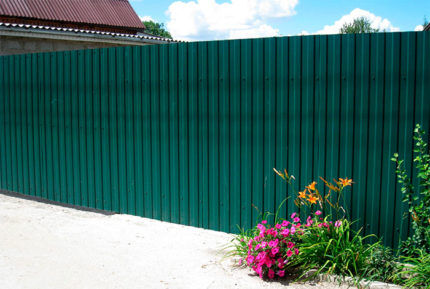
You can choose galvanized sheet - 20-30 year guarantee or coated polyester paint - a guarantee of 40-50 years, depending on the thickness of the coating. In the second case, manufacturers offer a wide range of colors - the fence will not only be durable, but also an attractive structure.
In addition to the fence, you can make sliding gates also from corrugated sheets.
What else will you need?
Except corrugated sheets, you will need to select components for the fence:
- pillars or support posts can be wooden, brick, reinforced concrete or metal. The last option is the most common. These can be profile or round pipes of various diameters. You can purchase ready-made fence posts, which are sold with a top cap, an installation heel and welded brackets;
- logs (transverse connections), just take pipes 40x40x2 mm/40x20x2 mm;
- brackets for mounting joists to poles for work without welding;
- accessories: bolts or screws M6 (20/30 mm), self-tapping screws or rivets.
Accessories and corrugated sheet should be selected taking into account the total weight of the fence. Heavier and more voluminous sheets require the installation of a frame made of profile pipes of significant parameters.
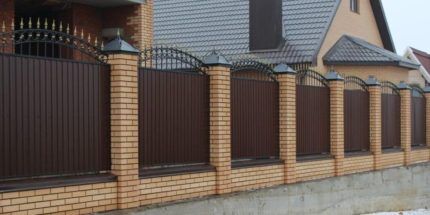
Additionally, you can purchase consumable items: paint, pipe plugs and top fence strips. Accurate calculation of materials and components will allow you to quickly complete construction and not spend extra money.
Calculation of the required amount of material
For a continuous fence, it is necessary to divide the perimeter of the structure by the width of one sheet, taking into account the overlap. For sectional ones, divide the perimeter into the number of sections if one sheet is installed, and into the usable width, taking into account the overlap when attaching 1.5-2 sheets. If the gate and wicket will be sewn up professional sheet, then you will need to add the amount of material taking into account their width.
To calculate the number of posts for a continuous fence, you need to divide the total length by the number of spans. As a rule, the distance between the supports does not exceed 2-3 m. For sectional ones: the distance between the pillars is equal to the width of the sheet or useful width if the span is filled with 1.5-2 sheets.
The height of the supports is calculated based on the height of the sheet and 30% for depth. It is necessary to take into account that the main supports will be required at the corners of the perimeter for the installation of gates and gates.
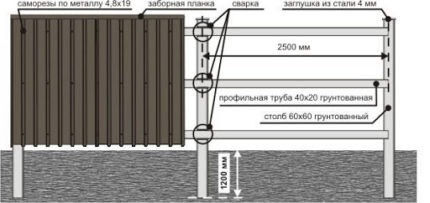
Transverse connections between pillars are purchased based on the following calculation: the perimeter is multiplied by 2 or 3, depending on the height of the fence. For example, if a fence 50 m long is being installed, then 100 logs will be required (structure height up to 1.5 m) and 150 pieces (for a higher version).
Fittings and components:
- holder plate or brackets, if the decision is made to work without welding: calculated by the number of pillars and joists;
- caps for the top of each post. You can purchase simple or decorative caps;
- hardware: fastenings are made along the two outer waves and through two waves in the lag. You will need 6/9 pieces with 2/3 cross connections. The total quantity will be obtained if the consumption per 1 sheet is multiplied by all sheets used in construction. Purchase hardware It’s more profitable in boxes of 250 pieces, rounding up the cost;
- end strip for decorating the top of the fence: the perimeter of the structure is divided by the length of one strip (2 m), taking into account the connecting overlap during installation;
- paint: you will need a spray can to paint over possible mechanical damage and chips.The paint markings must be identical to professional sheet.
For the work, you will need to purchase cement and sand to prepare the solution, take care of the necessary tools and construction containers.
Installation of a fence from profiled sheet
The installation of a fence made of corrugated sheets begins with preparing the site and marking the perimeter, taking into account the data in the drawing. Then the foundation is poured and support pillars are installed. At the next stage, the logs are attached to the support pillars and the profile sheets are mounted on the resulting frame.
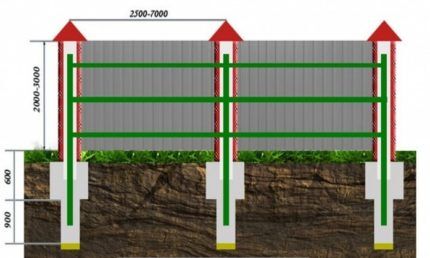
After all installation work is completed, you need to carefully inspect the structure for chips. If any are found, they are painted over to match the fence.
Each stage has its own characteristics and requires strict adherence to technology.
Stage #1 - marking the fence line
At the preparatory stage, the fence line is cleared of plants and foreign objects. It is recommended to cut or fill areas with particularly uneven terrain to prevent possible installation problems.
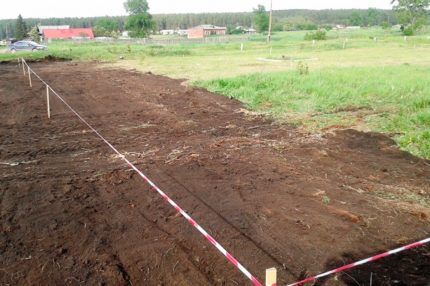
When marking the site, the extreme points are marked - the corners of the fence. Where installation of pillars is necessary, pegs are driven in there. The extreme points are connected with a cord, which will show the direct location of the fence.
Then beacons mark the location of intermediate supports (2-3 m) according to the drawing; in selected places, a plumb line or level determines the exact place where the pillars will be dug in.
Stage #2 - installation of support pillars
The method of installing the fence is selected: using a strip foundation or on poles. Fencing using profiled sheet refers to lightweight structures and does not require a buried foundation. If you decide to build a permanent foundation, then it will be quite suitable shallow foundation 300-400 mm.
To prevent soil heaving and ensure the reliability of the foundation, the following points should be taken into account:
- foundation for support pillars (at the corners of straight sections): the depth of the pit should be 30% of the height of the pillar;
- for intermediate pillars, a depth of 25% of the pillar height is sufficient;
- in both cases, it will be necessary to additionally take into account the space for the construction of a gravel-sand cushion;
- The width of the foundation may be insignificant; it must be selected taking into account the parameters of the racks.
When installing a strip foundation, a foundation pit is dug and formwork is installed (removable or permanent).
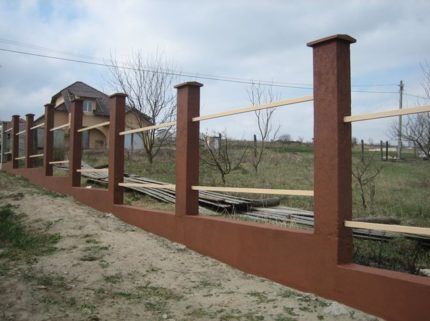
Pillars are installed at the designated points: the soil is removed with a drill, a cushion is made, and the plumb-aligned supports are concreted. Finally, the entire area is reinforced and filled.
With stable soils and simple landscapes, it is enough to simply concrete the pillars without pouring the foundation. After the concrete has reached its working strength, you can begin attaching the joists.
Stage #3 - installation of logs
The connection of support pillars can be done by welding and fastening. In the first case, welding is performed over the entire area of contact between the log and the pipe, having previously cleaned the surface.When using brackets, the help of a welder is not required, and this is an equally durable way to create a frame.
The crossbars can be secured in several ways: in front, end-to-end (optimally for solid structures), at the back through a bracket (for sectional models) and on the side of the support (for fastening not only to the joist, but also to the pole).
The choice of connection method depends on the type and length of the fence, as well as the requirements for the reliability and stability of the structure.
Stage #4 - fastening profiled sheet on the frame
To maintain the geometry of the sheet when mounting it on the frame, you need to attach the first sheet at the top point, align the second edge using a level and secure it. Then they put the rest self-tapping screws. Subsequent sheets are mounted with an overlap on the last wave of the previous sheet. Fastening is carried out only through the lower wave, in the place of maximum fit to the log.
It should be noted that self-tapping screws Do not overtighten, this will help preserve the gasket rubber. It is necessary to provide a distance from the leaf to the ground and avoid direct contact with the soil. Fastening is carried out from gate and gates, otherwise there may be a piece of sheet near them.
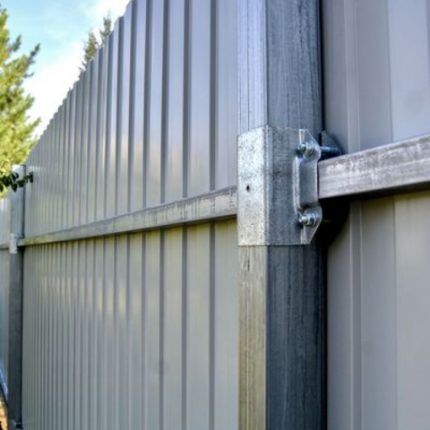
The final stage will be closing the end of the pipes with decorative caps or simple plugs. When deciding to install the upper strips, it is necessary to take into account the width of the wave to ensure a tight connection. The strips are attached at the ends, taking into account rolling or without it.
Conclusions and useful video on the topic
Detailed instructions for installing a fence using corrugated sheets. Which professional sheets and which coating option is best suited. When is a foundation needed and why? How to install fence posts and what characteristics need to be taken into account:
It is installation defects that cause problems with the subsequent operation of the fence. A well-installed fence corrugated sheets serves for a long time, decorates the area and protects from uninvited guests. If you decide to build a fence yourself, you should take into account the advice of the experts and everything will work out for you.
Have you ever encountered the installation of a fence made of corrugated sheets? What difficulties did you encounter during the installation process and how did you overcome them? Tell our readers about it. The contact form is located below the article.



